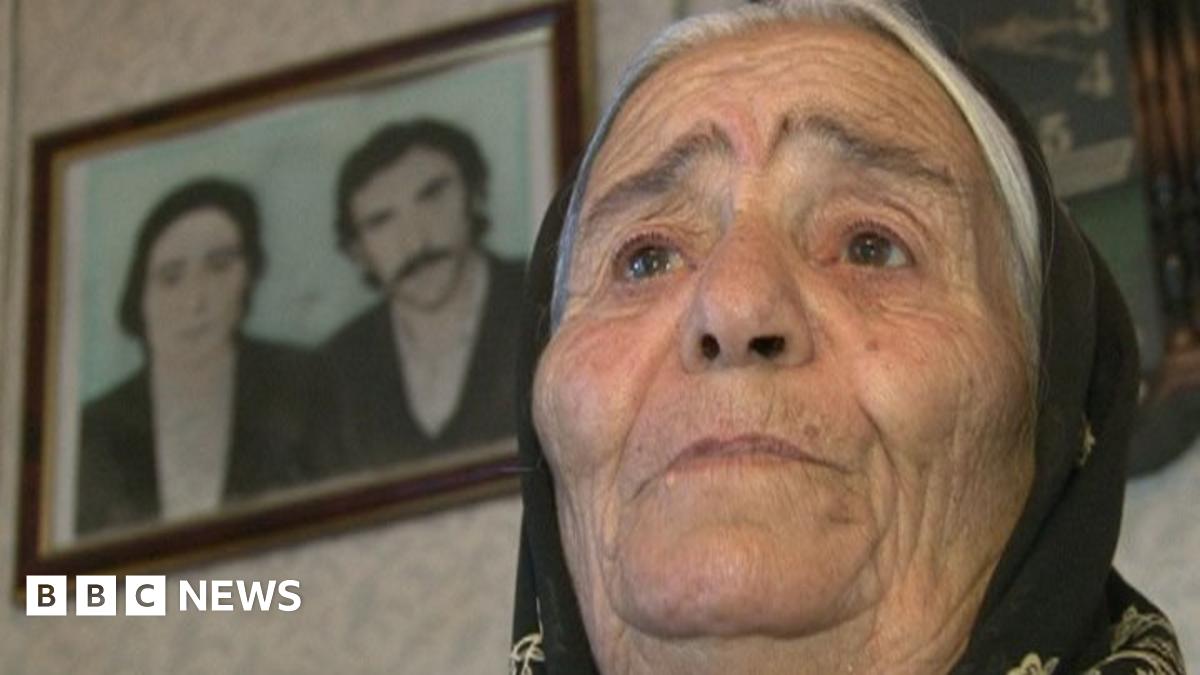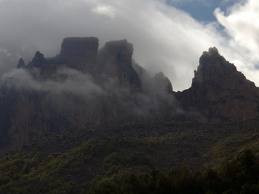Re: Military Forces of the Republic of Armenia
The BBC must have received a BIG bribe, or a phone call from BP
Antiga Gahramanova has been waiting two decades for a resolution to the war which forced her from her home - but fears are growing that the so-called frozen conflict of Nagorno Karabakh could spring back to life, more ferociously than ever.
A faded portrait hangs on the wall of the tiny room belonging to Mrs Gahramanova, who is now 80.
It shows a beautiful young couple with dark mournful eyes: Mrs Gahramanova's daughter and son-in-law.
Tears roll down her lined cheeks when she explains what happened to them during the war with Armenia two decades ago: "Armenian soldiers tied my son-in-law to a tree.
"And they burnt him alive, screaming. Then they fired a bullet into the side of my daughter's head."
Mrs Gahramanova and her daughter's four young children were forced to watch.
Continue reading the main story
Start Quote
The only thing that I want is to go back to my homeland, to die in the place where I was born
Antiga Gahramanova
Azerbaijani refugee
"Then they shot my six-year-old granddaughter dead," she said, wiping the tears away with her patterned headscarf.
"And they shot another granddaughter in the heel. They said it was to teach us a lesson."
She herself managed to escape. She hid under bushes for four days with the remaining three grandchildren before making her way through the snow, dragging the children with her.
For 20 years now Mrs Gahramanova has been living in a small room in a crumbling Soviet-era sanatorium. It is here that she has brought up her three orphaned grandchildren.
"The only thing that I want is to go back to my homeland, to die in the place where I was born. I just want to be able to go home," she says.
An estimated 600,000 Azerbaijanis, or 7% of the country's population, live similar existences in Soviet-era schools, hospitals or university buildings - families of five, six or seven people sharing one tiny room.
Often there is no bathroom - just a couple of foul squat toilets to be shared between hundreds of people.
In Armenia, meanwhile, around 10% of the population are refugees who fled from Azerbaijan, according to the Armenian political analyst, Alexander Iskandaryan.
Horrific atrocities were allegedly committed by both sides.
Strangers
Today attitudes are becoming more entrenched: a whole generation has grown up being fed a one-sided, and sometimes even false, interpretation of history, without ever meeting people from the other side of the border.
"For my students, Azerbaijanis are like something from the moon," says Mr Iskandaryan.
"They know more about Britain than about Azerbaijan. And the same goes for young people in Azerbaijan."
It was a brutal war over disputed territory, which broke out in 1991 amid the collapse of the former Soviet Union. The region of Nagorno Karabakh was in Azerbaijan but it was populated predominantly by Armenians.
Up to 30,000 people were killed and a million forced to flee their homes before a tenuous ceasefire was agreed in 1994. Most of those who were displaced during the war have never been allowed back.
Their homeland is now a war zone.
The disputed region is controlled by Armenia but Azerbaijan wants it back.
Hundreds of kilometres of deep trenches zigzag along the front line in western Azerbaijan. It all looks like something out of World War I.
At regular intervals there are raised parapets, protected by sandbags, with gaps to shoot through.
On the other side, just a few hundred metres away across no-mans-land and the battered remains of a vineyard, you can see a raised bank of earth, where Armenian snipers are stationed - presumably looking right back at us.
Both countries have signed a ceasefire but an official peace agreement has never been agreed. Peace talks meanwhile have stalled.
Soldiers say that shooting breaks out here on a daily basis, telling us that there was an exchange of fire at this position just a quarter of an hour before we arrived. Both sides blame the other, and say they only shoot in response.
Conscripts
What is clear is that over the past two years at least 60 people have been killed along the front line. Mostly soldiers, who on the Azeri side are often baby-faced conscripts in their teens or early twenties.
Azeri conscripts like Elham Mammadov are drafted to serve at the front
"I'm very proud to serve my homeland," says Elham Mammadov, a 19-year-old Azeri conscript, who has been stationed here at the front for eight months.
"And every day, every hour, I want the war to start, so that we can liberate our homeland from the Armenian aggressor."
He may sound like he is ready for a fight but he looks nervous.
Azeri villagers are also regularly fired on by snipers. They tend cattle and plough fields amid the remains of bombed-out villages within metres of the front.
There are fears the situation could again spiral out of control and, with more sophisticated weaponry available to both sides, analysts say a return to war could have even worse consequences.
"There are now offensive missile systems capable of hitting Baku and Yerevan, the capitals of Azerbaijan and Armenia," says Lawrence Sheets from the International Crisis Group.
"This is a conflict which has the danger of pulling in major regional powers."
That would mean Nato-member Turkey on one side and Russia on the other. And with Iran next door, and the region a crucial source of oil and gas for Europe, all-out fighting would have serious implications.
The BBC must have received a BIG bribe, or a phone call from BP

Antiga Gahramanova has been waiting two decades for a resolution to the war which forced her from her home - but fears are growing that the so-called frozen conflict of Nagorno Karabakh could spring back to life, more ferociously than ever.
A faded portrait hangs on the wall of the tiny room belonging to Mrs Gahramanova, who is now 80.
It shows a beautiful young couple with dark mournful eyes: Mrs Gahramanova's daughter and son-in-law.
Tears roll down her lined cheeks when she explains what happened to them during the war with Armenia two decades ago: "Armenian soldiers tied my son-in-law to a tree.
"And they burnt him alive, screaming. Then they fired a bullet into the side of my daughter's head."
Mrs Gahramanova and her daughter's four young children were forced to watch.
Continue reading the main story
Start Quote
The only thing that I want is to go back to my homeland, to die in the place where I was born
Antiga Gahramanova
Azerbaijani refugee
"Then they shot my six-year-old granddaughter dead," she said, wiping the tears away with her patterned headscarf.
"And they shot another granddaughter in the heel. They said it was to teach us a lesson."
She herself managed to escape. She hid under bushes for four days with the remaining three grandchildren before making her way through the snow, dragging the children with her.
For 20 years now Mrs Gahramanova has been living in a small room in a crumbling Soviet-era sanatorium. It is here that she has brought up her three orphaned grandchildren.
"The only thing that I want is to go back to my homeland, to die in the place where I was born. I just want to be able to go home," she says.
An estimated 600,000 Azerbaijanis, or 7% of the country's population, live similar existences in Soviet-era schools, hospitals or university buildings - families of five, six or seven people sharing one tiny room.
Often there is no bathroom - just a couple of foul squat toilets to be shared between hundreds of people.
In Armenia, meanwhile, around 10% of the population are refugees who fled from Azerbaijan, according to the Armenian political analyst, Alexander Iskandaryan.
Horrific atrocities were allegedly committed by both sides.
Strangers
Today attitudes are becoming more entrenched: a whole generation has grown up being fed a one-sided, and sometimes even false, interpretation of history, without ever meeting people from the other side of the border.
"For my students, Azerbaijanis are like something from the moon," says Mr Iskandaryan.
"They know more about Britain than about Azerbaijan. And the same goes for young people in Azerbaijan."
It was a brutal war over disputed territory, which broke out in 1991 amid the collapse of the former Soviet Union. The region of Nagorno Karabakh was in Azerbaijan but it was populated predominantly by Armenians.
Up to 30,000 people were killed and a million forced to flee their homes before a tenuous ceasefire was agreed in 1994. Most of those who were displaced during the war have never been allowed back.
Their homeland is now a war zone.
The disputed region is controlled by Armenia but Azerbaijan wants it back.
Hundreds of kilometres of deep trenches zigzag along the front line in western Azerbaijan. It all looks like something out of World War I.
At regular intervals there are raised parapets, protected by sandbags, with gaps to shoot through.
On the other side, just a few hundred metres away across no-mans-land and the battered remains of a vineyard, you can see a raised bank of earth, where Armenian snipers are stationed - presumably looking right back at us.
Both countries have signed a ceasefire but an official peace agreement has never been agreed. Peace talks meanwhile have stalled.
Soldiers say that shooting breaks out here on a daily basis, telling us that there was an exchange of fire at this position just a quarter of an hour before we arrived. Both sides blame the other, and say they only shoot in response.
Conscripts
What is clear is that over the past two years at least 60 people have been killed along the front line. Mostly soldiers, who on the Azeri side are often baby-faced conscripts in their teens or early twenties.
Azeri conscripts like Elham Mammadov are drafted to serve at the front
"I'm very proud to serve my homeland," says Elham Mammadov, a 19-year-old Azeri conscript, who has been stationed here at the front for eight months.
"And every day, every hour, I want the war to start, so that we can liberate our homeland from the Armenian aggressor."
He may sound like he is ready for a fight but he looks nervous.
Azeri villagers are also regularly fired on by snipers. They tend cattle and plough fields amid the remains of bombed-out villages within metres of the front.
There are fears the situation could again spiral out of control and, with more sophisticated weaponry available to both sides, analysts say a return to war could have even worse consequences.
"There are now offensive missile systems capable of hitting Baku and Yerevan, the capitals of Azerbaijan and Armenia," says Lawrence Sheets from the International Crisis Group.
"This is a conflict which has the danger of pulling in major regional powers."
That would mean Nato-member Turkey on one side and Russia on the other. And with Iran next door, and the region a crucial source of oil and gas for Europe, all-out fighting would have serious implications.





Comment